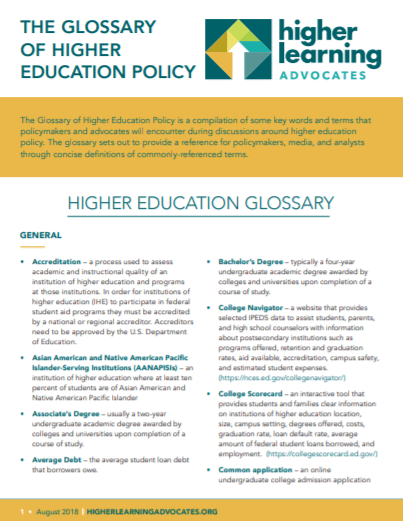101s & Backgrounders
101: Equity Gaps in Higher Education
What is an Educational Equity Gap? An educational equity gap is where there is a significant and persistent disparity in educational attainment between different groups of students. The equity gap that exists between white students and students of color begins in K-12 education — where 87 percent of white students graduate high school on-time compared…
101: FAFSA
What is the FAFSA? The Free Application for Federal Student Aid (FAFSA) is a federal application that will determine a student’s eligibility for federal grants, loans, and work-study programs. All students who wish to participate in Title IV federal financial aid programs must complete the FAFSA. Many states and most institutions of higher education require…
101: Negotiated Rulemaking
A Quirk of Federal Higher Education Policy: Negotiated Rulemaking The Higher Education Act (HEA) requires the U.S. Department of Education (ED) to use a process called “negotiated rulemaking” in order to make any changes to programs authorized under HEA’s Title IV, the section that houses federal financial aid programs and affects more than $130 billion…
101: Income-Driven Repayment (IDR)
What is Income-Driven Repayment (IDR)? Income-driven repayment (IDR) is a federal student loan repayment program that allows students to repay their loans based on their income, family size, and loan balance. Since 1994, the federal government has offered income-driven repayment plan options to help borrowers with lower earning power repay loans at a slower pace…
The Glossary of Higher Education Policy
Today’s students need a bipartisan and comprehensive rewrite of the Higher Education Act that upgrades quality, strengthens affordability, and promotes the more accountable system of higher education today’s students deserve. Learn to speak higher ed wonk with our resource, “The Glossary of Higher Education Policy”, which provides definitions of commonly-referenced terms in higher ed policy.…
101: Pell Grant Rainy Day Fund
What is the Pell Grant Program? The Pell Grant program is a federal means-tested program that offers postsecondary aid in the form of a grant to be used for tuition, fees, and related expenses. Operated by the U.S. Department of Education’s (ED) Office of Financial Student Aid (FSA), the Pell Grant program is available on…
101: Competency-Based Education
More and more of today’s students are adults, parents and older students who are learning outside the traditional academic calendar and often bring substantial work experience and existing college credit. Increasingly, some colleges and universities are measuring a student’s progress based on learning instead of time using competency-based education (CBE). What is Competency-Based Education (CBE)?…
101: Accreditation
What is Accreditation? Accreditation is the linchpin of the federal role in higher education as the gate-keeping system for the federal government’s $120 billion annual investment in higher education. Looking to understand the complex and esoteric process that determines which colleges and universities get a “stamp of approval” to receive federal student aid? Our new…


